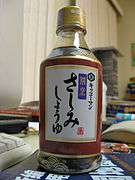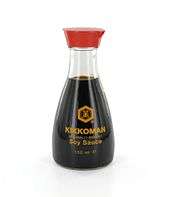Kikkoman
 | |
 | |
Native name | キッコーマン株式会社 |
|---|---|
| Public | |
| Traded as | TYO: 2801 |
| Industry | Food processing |
| Founded | December 7, 1917 |
| Headquarters | Noda, Japan |
Key people |
Yuzaburo Mogi, (Chairman) Noriaki Horikiri (CEO and President) |
| Products | Food products, beverages, biochemical products, management services |
| Revenue |
|
|
| |
Number of employees | 5,622 |
| Website | kikkoman.com |
|
Footnotes / references [1][2] | |
Kikkoman Corporation (キッコーマン株式会社 Kikkōman Kabushiki-gaisha) is an international food and drink company based in Japan. Its main products and services include soy sauce, food seasoning and flavoring, mirin, shōchū, and sake, juice and other beverages, pharmaceuticals, and restaurant management services.
Kikkoman has production plants and offices in Japan, the U.S., the Netherlands, Singapore, Taiwan, China and Canada.[3] Kikkoman is the most popular brand of soy sauce in Japan[4] and the United States.[5][6] The village of Sappemeer in Groningen, the Netherlands, is the European headquarters of the company. A plant on the site began operations in 1997 and now produces over 400 million litres of soy sauce per annum.[7]
History
Founded in 1917, it is based in Noda, Chiba Prefecture, Japan. It is a combination of 8 family-owned businesses founded as early as 1603 by the Mogi and Takanashi families.[8]
Kikko, which means tortoise shell in Japanese, and man, meaning 10,000, were chosen first as the trademark and later as the company name. This was to symbolize longevity, as according to Japanese folklore a tortoise lives for 10,000 years. This symbolism is found in Kikkoman's logo, which is a rebus that consists of the Chinese character for 10,000 surrounded by a hexagon, representing a tortoise shell;[9] see Japanese rebus monogram for more examples.
Products
Soy sauce
Kikkoman soy sauce is naturally brewed. After soaking in water for an extended period, soy beans are steamed at high temperature before they are mixed with crushed roasted wheat. Salt is added, which acts as an anti-bacterial agent and preservative. Next, a genus of the Aspergillus fungus is added to the mixture and left for three days to create shoyu koji, the base for the soy sauce. This base is then transferred to a tank and mixed with a saline solution, which creates a mash known as moromi. Several months of aging follow, when various organic processes occur including lactic acid, alcoholic and organic acid fermentation take place to create unique flavours. The moromi is then mechanically pressed through layers of fabric for around ten hours to extract the raw product. In the last part of the process, the raw soy sauce is left to separate for 3–4 days, then pasteurised using steam, which also stops any enzymic activity. The final product is then ready for inspection and bottling.[10] Kikkoman has a distinctive bottle for its soy sauce, designed by Kenji Ekuan in 1961.[11]
Kikkoman also makes teriyaki sauce, which was introduced in 1968.
Gallery
|
References
- ↑ "Corporate Profile". Retrieved July 25, 2014.
- ↑ "Kikkoman Financial Statements". Bloomberg Businessweek. Retrieved July 25, 2014.
- ↑ "Message from the Management". Retrieved 25 July 2014.
- ↑ Factbook Business Information Fiscal 2008
- ↑ Story of Soy Sauce
- ↑ Factbook Business Information Fiscal 2008
- ↑ "Groningen in Beeld" (in Dutch). RTV Noord. Retrieved 17 June 2015.
- ↑ Shurtleff, William; Aoyagi, Akiko. 2012. History of Soy Sauce (160 CE to 2012). Lafayette, California. 2,523 pp. (8,554 references, 228 photos and illustrations. Free online).
- ↑ http://www.kikkoman.com/corporateprofile/overview/index.shtml.
- ↑ "Making Soy Sauce". Kikkoman Corporation. Retrieved 4 December 2014.
- ↑ "Japanese designer behind iconic soy sauce bottle dies at 85". ABS-CBN News. 9 February 2015. Retrieved 9 February 2015.


